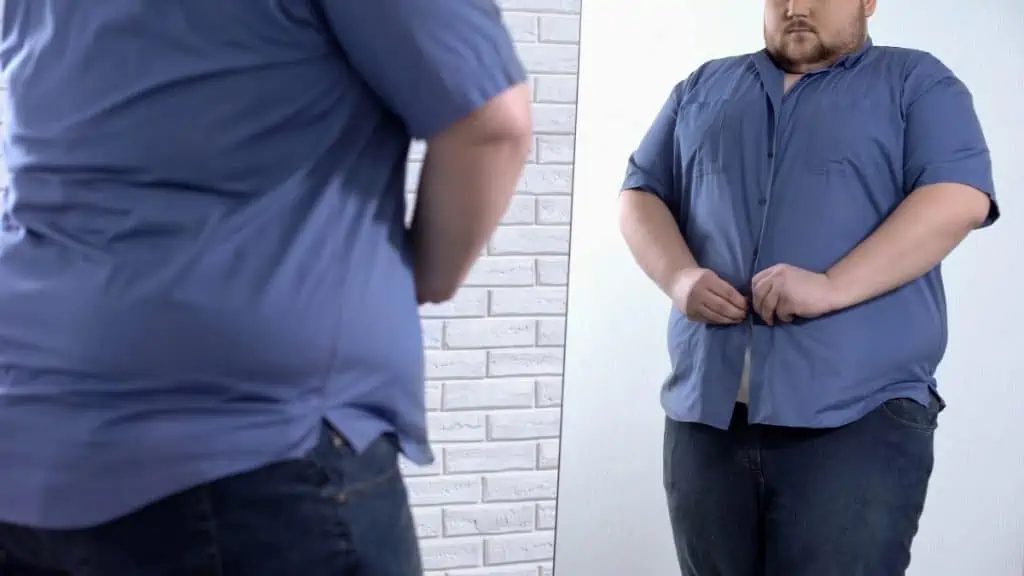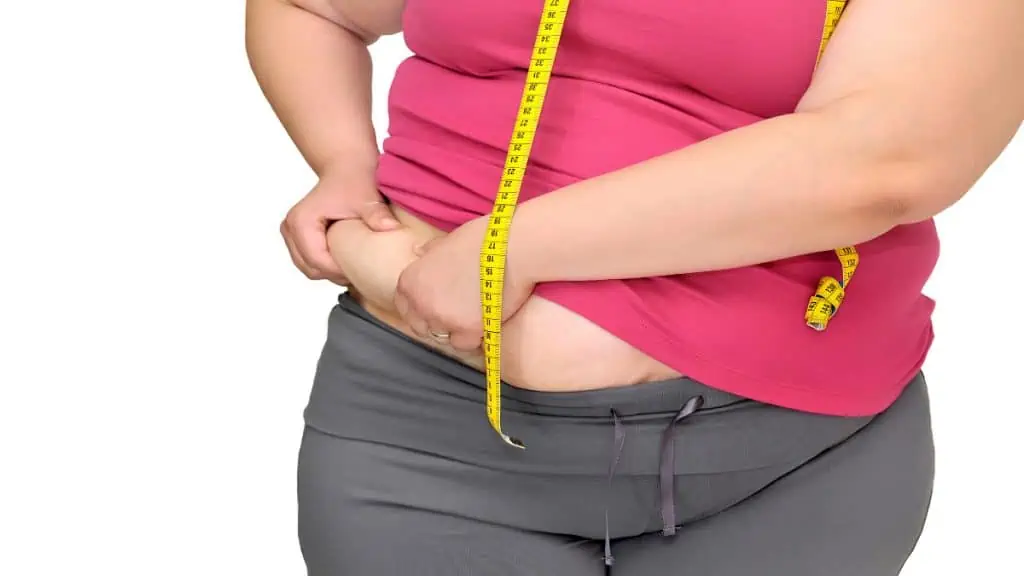You don’t acquire a 65 inch waist or a 66 inch waist over the course of weeks and months; it takes years of overeating paired with a sedentary lifestyle for anyone to end up with a 65″ waist.
But the silver lining, of course, is that the worse off you are now, the more dramatic your transformation will be when you do lose the weight.
With this in mind, the following article will go over some consequences of having a 65 in waist and then arm you with some proven tactics for losing fat and keeping it off for good.
Related Guides:
- What is the average waist size for a woman?
- 60 inch waistline
- 62 inch waistline
- 63 inch waistline
- 64 inch waistline
- 67 inch waistline
- 68 inch waistline
How concerned should you be about having a 65 inch waist?

Considering that being obese can lead to problems like diabetes, hypertension, and heart disease, you should be very concerned about having a 65 inch waist if you care about your physical health.
While there’s no need to be skinny or ripped, you simply can’t be healthy while having a 65 inch waistline.
Having a high BMI is often indicative of being obese, but since certain people have more muscle mass than others, [1] waist circumference is a more accurate indicator of your central adiposity (basically, how much fat you store on your stomach).
With that in mind, tracking your waist measurement on a monthly, weekly, or even daily basis can help you to validate the effectiveness of your diet and workout routine. Of course, if you do decide to measure your waistline frequently, you can’t expect to see significant waist size reductions every day or week.
However, taking more frequent measurements will allow you to see the incremental changes in your stomach size, which may help to keep you motivated and on track.
How can you go about losing your 65 inch waist?

As any dietician will tell you, losing weight means that you need to be in an energy deficit. In other words, you have to expend more energy than your body takes in. In general, this means reducing your calorie intake a bit and increasing the frequency and intensity of your physical activity.
In terms of macronutrients—protein, fats, carbohydrates—protein is often said to be the most satiating and can actually lead to higher levels of energy expenditure. [2] As such, you should aim to include dairy, lean meats, fish, beans, and nuts in your diet—foods that will also help to build and strengthen your muscles. There are loads of tasty recipes online that contain these delicious and versatile foods.
If you have a 65″ waist, then certain types of exercise are naturally going to be much more challenging than others. For example, if you can’t do many burpees, you could burn calories by working out with dumbbells and resistance bands instead (or as well) because you don’t need to lift your body weight to use these types of fitness equipment.
While you might not think that lifting weights is the best way to slim your 65 in waist, it actually is. Strength training builds lean muscle mass, burns plenty of calories, and, if you perform the exercises one after the other, really challenges your cardiovascular system as well, which improves your fitness levels.
What are the benefits of slimming your 65 in waist?

Losing significant amounts of weight will drastically improve your health, such as lowering your risk of high blood pressure, stroke, and type 2 diabetes. [3]
In terms of mental health, you’re much more likely to feel better about yourself if you’re able to successfully slim your 65 inch waist or 66 inch waist because it feels like you’ve accomplished something great.
You’ll think to yourself, gosh, if I can lose all this weight, what else am I capable of?
Additionally, you’ll have more energy once you start eating healthy foods and being more active. Having more vitality will help you to get more joy from your life, which can make even simple everyday activities like walking in the park really enjoyable.
Conclusion: How big is a 65 inch waist?

A 65 inch waist is, of course, much bigger than average. But when you’re seriously overweight, fat loss can often occur faster since you have more body mass to lose. So the initial weight loss can be quite significant, which can help to keep you motivated and prove to you that your diet and exercise regime are working.
Of course, you can’t keep on losing loads of weight forever. Indeed, as your stomach slimming journey progresses, you might have weeks where you don’t lose any weight at all. If this happens for multiple weeks in a row, then you can create a bigger energy deficit by either lowering your calories a bit more or by bumping up your activity level.
References
- Rush, E. C., Freitas, I., & Plank, L. D. (2009). Body size, body composition and fat distribution: comparative analysis of European, Maori, Pacific Island and Asian Indian adults. British Journal of Nutrition, 102(04), 632. https://doi.org/10.1017/s0007114508207221
- Bray, G. A., Smith, S. R., de Jonge, L., Xie, H., Rood, J., Martin, C. K., Most, M., Brock, C., Mancuso, S., & Redman, L. M. (2012). Effect of Dietary Protein Content on Weight Gain, Energy Expenditure, and Body Composition During Overeating. JAMA, 307(1), 47. https://doi.org/10.1001/jama.2011.1918
- Healthy weight loss – British Nutrition Foundation. (2022). British Nutrition Foundation. https://www.nutrition.org.uk/health-conditions/overweight-obesity-and-weight-loss/healthy-weight-loss/

